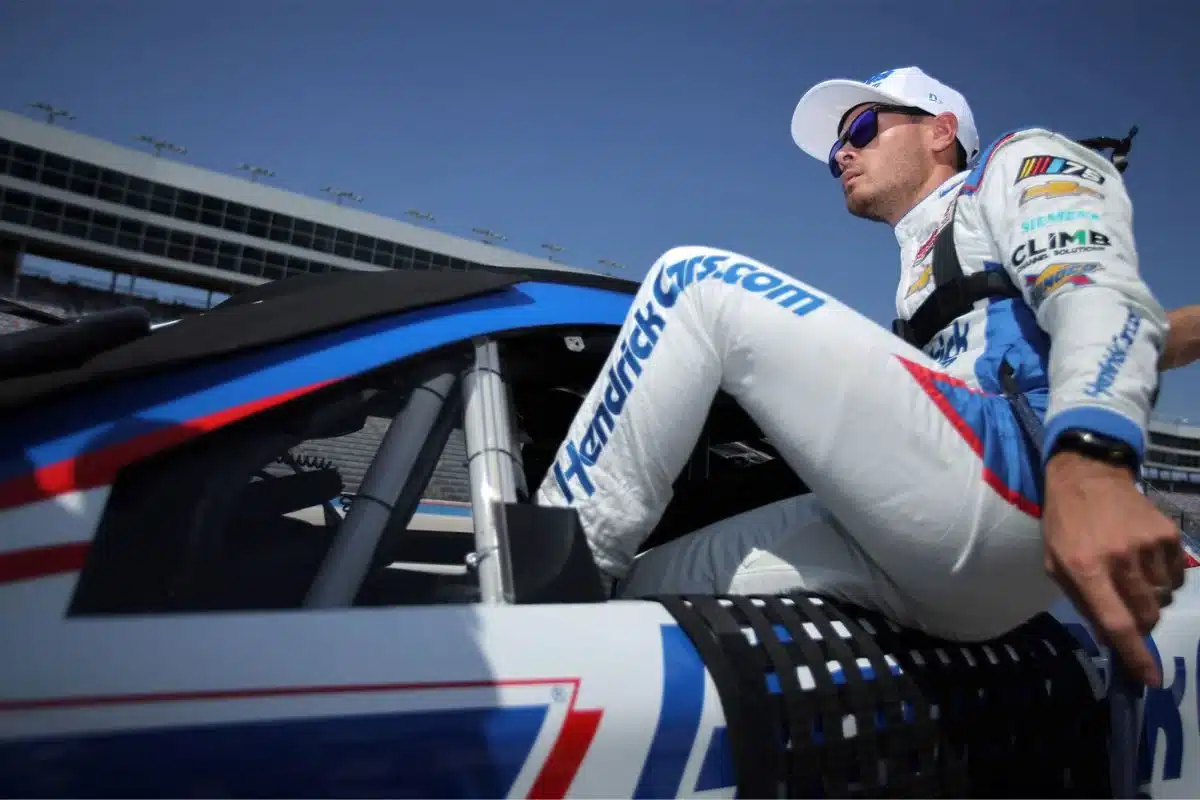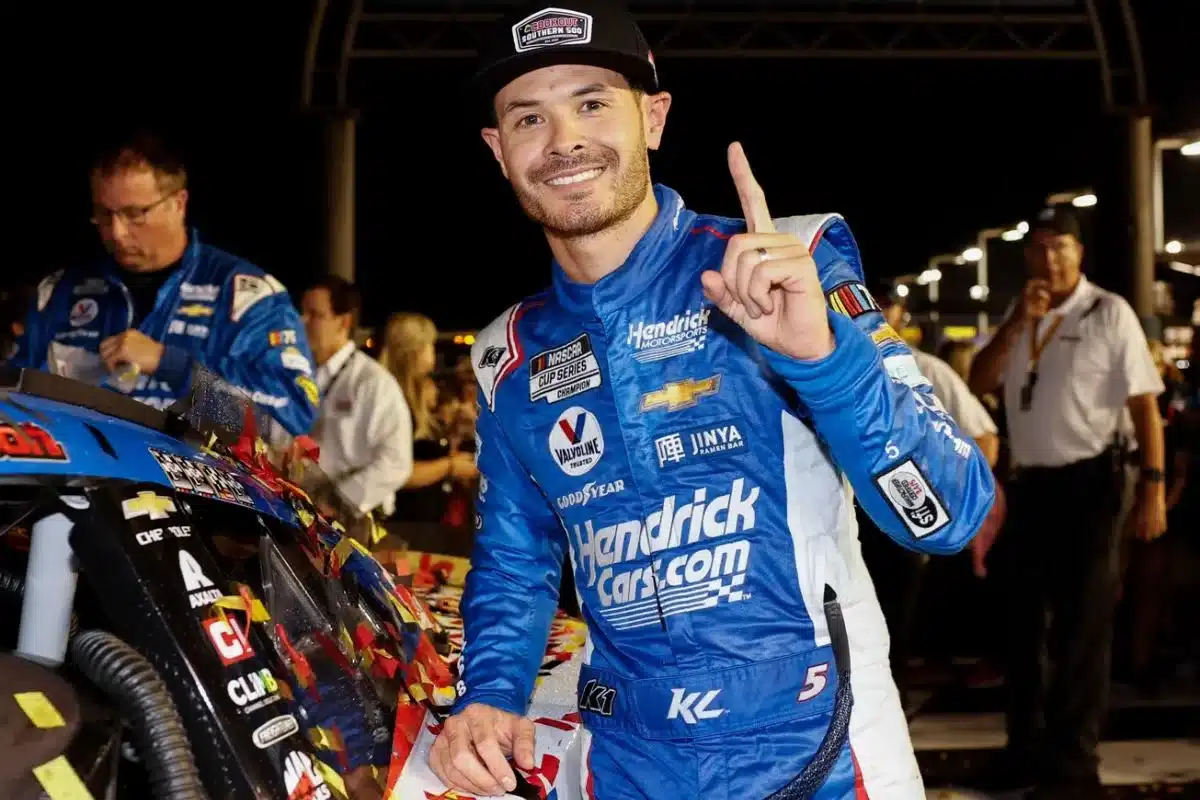Kyle Larson’s Take on Bristol Race: Kyle Larson’s perspective defies arcade-like racing norms at Bristol, revealing the variations of tire management and strategic thinking on the challenging concrete track. His adaptability propelled him to a top-five finish, showcasing racing intelligence. Larson’s post-race critique highlighted concerns over tire wear and track conditions, hinting at the principle challenges. Denny Hamlin’s perspective echoed Larson’s insights, emphasizing the need for precision in a race where driver influence proved pivotal. Larson’s take offers a deeper understanding of the complexities faced by drivers in balancing virtual expectations with the harsh realities of Bristol’s demands.
Key Takeaways
- Larson found the Bristol race ‘weird and interesting,’ questioning its reality.
- Dissatisfaction with tire wear and track conditions raised concerns about the race’s authenticity.
- Larson’s adaptability and strategic decisions showcased real-world racing skills.
- Critical view of Goodyear hinted at discrepancies between arcade-like expectations and real racing challenges.
- Larson’s fifth-place finish highlighted the demanding nature of Bristol, emphasizing reality over arcade-like ease.
Setting the Stage: Bristol Race Conditions and Kyle Larson’s Response
Setting the stage for the Bristol race conditions, Kyle Larson’s response to the recent Cup Series event at Bristol Motor Speedway sparked controversy within the NASCAR community. Known for its challenging surface shifts, Bristol Motor Speedway switched from its traditional dirt setup back to concrete for the Food City 500 race in the 2024 season. This modification brought forth tire wear issues that added complexity to the already demanding track.
The weekend was not devoid of excitement, as the Truck Series race on Saturday had already showcased the impact of tire wear on the drivers. The Cup Series drivers faced a similar challenge on Sunday afternoon, with tire management becoming an essential aspect of their performance. While the changes to the track were aimed at enhancing the racing experience, not all drivers were pleased with the conditions.
Hendrick Motorsports’ Kyle Larson, in particular, expressed his dissatisfaction with the Bristol surface, comparing the experience to a surreal video game. Larson’s tweet represented his disbelief at the conditions he was facing during the race. Despite his reservations, Larson managed to secure a commendable fifth-place finish, showcasing his skill and adaptability in maneuvering the challenging Bristol track. The race not only tested the drivers’ abilities but also ignited discussions within the NASCAR community about the impact of track conditions on the overall racing experience.

Kyle Larson’s Performance and Reaction
Kyle Larson’s exceptional performance and reaction during the Food City 500 at Bristol Motor Speedway exemplified the strategic challenges faced by drivers on the challenging track. Larson’s ability to maneuver the complexities of tire management and capitalize on the advantage of fresh tires showcased his skill and adaptability behind the wheel. Despite the race’s unusual conditions, Larson demonstrated his prowess by finishing fifth, a proof to his racing acumen.
Larson’s multifaceted approach to the race, highlighting how his performance and reactions were pivotal in negotiating the challenges posed by the Bristol Motor Speedway.
“Couldn’t believe what I was seeing out of my windshield. Real life arcade game.” – Quoted by Larson
Kyle Larson on new tires during the 2024 Food City 500 @ Bristol.
— Andrew (@Basso488) March 20, 2024
Larson: "This is crazy" pic.twitter.com/CLtqBmT9oY
Kyle Larson’s Post-Race Comments
Following the conclusion of the Food City 500 at Bristol Motor Speedway, Kyle Larson articulated his perspective on the race’s unique challenges and his experiences behind the wheel. Larson’s post-race comments shed light on the intricacies of the event and his dissatisfaction with certain aspects of the race.
- Unmet Expectations: Larson described his initial anticipation of rubber being laid down on the track, only to realize after the second run that this expectation was not met. This discrepancy between expectation and reality likely impacted his race strategy and overall performance.
- Dissatisfaction with Race: Larson expressed his discontent with the race, labeling it as ‘weird and interesting.’ His hope to avoid such races in the future suggests a level of discomfort with the conditions faced at Bristol Motor Speedway during the Food City 500.
- Concerns Over Tire Wear: The driver highlighted the issue of tire wear, mentioning the challenges posed by the inability to lay down rubber on the track. This concern not only affected his race but also raised questions about the track conditions and the impact on overall driver experience.
- Critical View of Goodyear: Larson’s comments hinted at a perceived shortfall on Goodyear’s part, as he suggested that the race’s challenges could reflect negatively on the tire manufacturer. This critique adds complexity to the post-race analysis and raises questions about the role of tire suppliers in NASCAR races.
“I thought some rubber was gonna be laid down, but after the second run, we realized that wasn’t going to be the case. I hope I never have to run a race like that again. To have to run a race like that every week would not be good, and it’s honestly probably a black eye to Goodyear just with all the rubber that couldn’t get laid down and just wearing through tires and all that.” – Quoted by Larson
Denny Hamlin’s Perspective on the Race
Denny Hamlin’s perspective on the Bristol race shows the pivotal role of driver skill and technique in mastering the unique challenges presented by the track. As the race winner, Hamlin emphasized the critical need for drivers to perform at their peak to be competitive at Bristol. He highlighted that in this particular race, the driver’s influence on the outcome was more significant than in previous events. According to Hamlin, the conventional strategy of full-throttle racing along the bottom of the track was replaced by a different approach that required finesse and precision. He pointed out that technique played a substantial role in determining success on race day.
Hamlin’s remarks align closely with Kyle Larson’s observations regarding the distinct nature of the Bristol track and the demanding nature of the race. Both drivers agree on the exceptional challenges posed by the circuit and the necessity for drivers to exhibit exceptional skill to navigate it effectively. By emphasizing the shift in driving philosophy and the heightened importance of technique, Hamlin provides valuable insights into the strategic and tactical aspects of competing at Bristol. His perspective enriches the understanding of how drivers adapt to and excel in unique racing conditions, shedding light on the complexities of mastering a track like Bristol.
“This is the first time the driver played a huge role in a long, long time,” Hamlin said. “It’s a different philosophy from what we’re used to. Which is everyone just kind of on the gas all the time running the bottom. Technique was a huge deal today.”

News in Brief
The Bristol race conditions, Kyle Larson’s perspective on the event as resembling an arcade rather than reality raises questions about the nature of competition in NASCAR. His performance and reactions on the track reflect a nuanced understanding of the challenges posed by the unique track layout.
Denny Hamlin’s contrasting viewpoint adds depth to the discussion, highlighting the complexities of racing dynamics at Bristol. The varying perspectives shed light on the multifaceted nature of NASCAR competition.
Our Reader’s Queries
Q. What kind of racing does Kyle Larson do?
A. Kyle Miyata Larson, born on July 31, 1992, is a prominent American professional auto racing driver. He currently holds a full-time position in the NASCAR Cup Series, where he commands the No. 5 Chevrolet Camaro ZL1 under the banner of Hendrick Motorsports. Additionally, Larson engages in part-time competition in the NASCAR Xfinity Series, steering the No. 17 Chevrolet Camaro for the same esteemed team.
Q. Why is Kyle Larson called Yung money?
A. Larson quickly earned the moniker “Yung Money” in the early stages of his career, attributed to his remarkable versatility across various racing series and his consistent ability to contend fiercely and emerge victorious in any race car. His extensive list of triumphs serves as compelling evidence to support this nickname. This development was noted on January 8, 2022.
Q. Who owns Kyle Larson Sprint car?
A. Kyle Larson Racing, formerly known as Larson Marks Racing, stands as an American sprint car and midget car racing outfit under the ownership of NASCAR driver Kyle Larson.
Q. Does Kyle Larson own a race team?
A. High Limit Racing was established and is owned by the 2021 NASCAR champion, Larson, alongside Brad Sweet, a five-time World of Outlaws champion.
ALSO READ: Kyle Larson Teases 1000 HP NASCAR Engines: A Game Changer?


